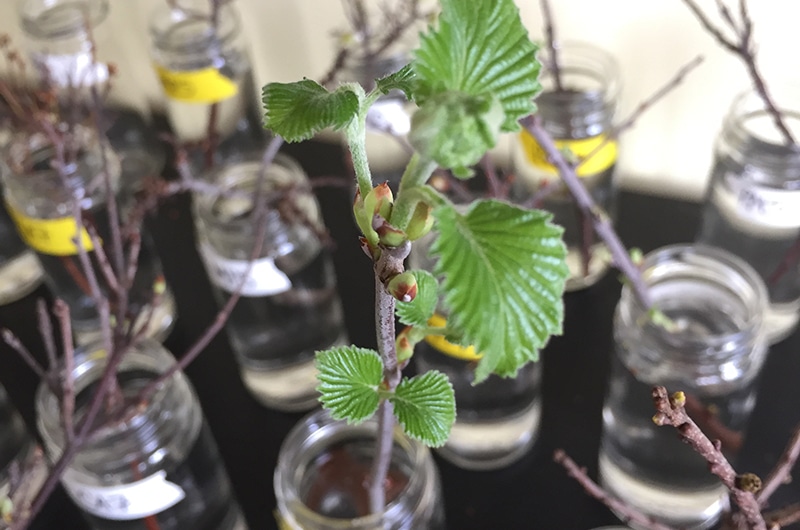Dr. Sarah Treanor Bois
Director of Research & Education at the Linda Loring Nature Foundation
With daffodil season upon us, people on Nantucket are abuzz about spring. Who saw the first osprey, who heard the first peepers and in what pond, and where did the first daffodils bloom (the Atheneum garden, usually)? These observations make for great conversation after the long winter, but this isn’t just fodder for cocktail parties. These observations of nature’s timing are real data. The study of seasonal natural events, usually related to climate, is called phenology.

We look for cues in nature for when to plant seeds, when the fish are running, and when to watch for our favorite birds migrating. Whether you’re a farmer planting crops, a birder awaiting spring migration, a business owner hoping for good numbers over Daffodil Weekend, or a child listening for spring peepers, you’re paying attention to nature’s timing. The study of phenology has been around for thousands of years. One of the earliest continual data sets looking at plant timing comes from Kyoto, Japan where people have been recording cherry blossom bloom time since the year 800 AD.
In the U.S., the National Lilac Project has been recording first flowering dates for lilac species and varieties since the early 1950s. Nationally, projects like the National Phenology Network (NPN) are organizing professionals and citizen scientists to collect data on phenological events for plants and animals. NPN standardizes data collection and makes the data, research, and educational resources available for anyone to use and learn from.
Not only are these types of records interesting and useful to us in our own home, we can use these long-term datasets to investigate changes to the timing of things. In fact, the cherry blossom data from Japan has been used to show that cherry bloom time is now, on average, 10 days earlier than it was for centuries. In our own backyard, Dr. Richard Primack from Boston University has shown that flowering times for many New England native plants are about 7 days earlier than they were in the 1850s, which tracks with the warming temperatures associated with climate change. So, what does this mean for Nantucket?
Springtime temperatures have been arriving earlier on Nantucket, just like most of New England. There is year-to-year variation, but generally we are seeing springtime temperatures arriving 2 to 4 days earlier than the historic average. What does that mean for our plant species?
On Nantucket, we at the Linda Loring Nature Foundation (LLNF) are gathering baseline data on phenological events by observing leaf buds, bud burst, flowering buds, and full flower of multiple plant species. We are tracking the phenology of several native shrubs as well as the Sandplain Blue-eyed Grass, a Species of Special Concern in Massachusetts. Having this baseline of data will help us to detect any changes that may occur to this timing as our climate changes. We’re also collecting data on hatch time and activity of the eastern tent caterpillar. Spring-hatching caterpillars, such as this native species, are particularly responsive to temperature. Along with the phenological observations, we’re collecting temperature and light data at various locations across the property to link current variation in plant timing to temperature, light, and slight elevation changes found throughout the property.
To complement these field observations, we are also conducting experiments looking at the effects of earlier spring warming on our shrub species. By forcing early temperatures on our representative shrubs, we note the timing of leaf out in response to temperature changes.
While our results are preliminary, research at LLNF has shown that some of our native shrubs (lowbush blueberry, for example) can track the earlier spring warming and leaf out with the warm temperatures. However, just because they leaf out earlier, doesn’t mean they can just cruise into a longer growing season. Springs is also becoming more erratic with more frequent late frost events. Some of our species, like black huckleberry, have been topkilled during late frost events. This is the type of affect which, if it becomes a pattern, could have devastating effects of the overall population.
Other species, such as black cherry and beach plum, aren’t able to respond as nimbly to warming temperatures resulting in a delayed phenology from surrounding species.
Why does this matter? As the climate warms and phenological events change, mutualisms may become out of sync. For example, pollinators may be late to the party if flowers open early. Migrating birds which time their movements based on day length may miss the hatch of their favorite caterpillars which they rely on for nourishment during nesting season.
At LLNF, we’ll continue to collect phenology data and will be adding new species to our protocols. Designed as a long-term project, we will continue to complement field data with experimental research. We’re using this phenology project as part of our Citizen Science objective at LLNF. Check out llnf.org for more about our phenology projects and how you can get involved. The data we’re collecting are also being entered into the National Phenology Network database. Thus, the phenology data will be useful to us on the island, but also contribute regionally and nationally.